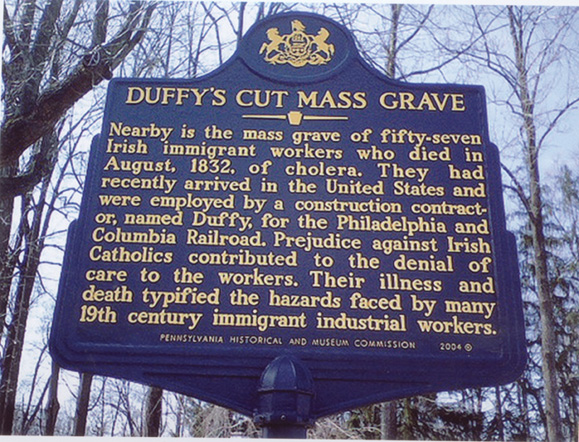A new chapter of the harsh and often brutal experience of Irish immigrants in America is literally being unearthed thanks to the efforts of local historians Bill and Frank Watson of Pennsylvania. They are currently undergoing excavation of a site known as Duffy’s Cut in Pennsylvania, a railroad construction site dating back to the nineteenth century. Their research has uncovered a mass grave of Irish immigrants at the site where 57 of them were thought to have perished from cholera. The brothers Watson began researching in 2002 after they found references to the laborers in a document kept by the then president of the company Martin Clement, of whom their grandfather was a personal assistant. The documents showed that all 57 were immigrants from Ireland and were killed by an outbreak of cholera. While cholera may have been part of the story, new information shows that foul play was at work. In 2009, a human tibia and a shinbone were found, and later a human skull that had been pierced by a bullet and cleaved with a hatchet. Bill Watson related to Reuters that “we have no idea what percentage of these guys were murdered, but if we have 57, it’s the worst mass murder in Pennsylvania history.”
These new discoveries shed light on the thousands of immigrants who built the American infrastructure throughout the 19th and 20th centuries and the many perils they faced. In 1828 in Pennsylvania, a contractor named Philip Duffy was commissioned to work on a railroad that would connect the Columbia and Philadelphia lines. Workers were picked right off the boat, as was the case in Duffy’s Cut, and given minimal wages and filthy accommodations. A cholera outbreak in 1832 ravaged the newly arrived immigrants, and those who succumbed to the disease were buried in mass graves. Modern forensics discovered that at least three bodies show signs of a violent death. Some historians believe that these deaths may have been caused by local residents who were angry over the influx of immigrants and loss of wages.
Janet Monge, a forensic anthropologist at Pennsylvania State University, sheds light on the experience of the immigrant saying, “It was a cruel and rugged existence that characterizes the immigrant experience, and it speaks very broadly of the xenophobia that existed at the time.”
Identification of the bodies has been difficult because no census records or obituaries of the dead exist. One of the bodies identified through dental analysis was John Ruddy who died at 18. Last year his descendants were contacted in Ireland and his remains were reburied there. Work goes on slowly at the site which is now owned by Amtrak as negotiations are put forward to begin further digging, but the team, which consists of historians, anthropologists, and volunteers, are optimistic that they will be getting back to work soon.
Excavation of Duffy’s Cut Continues


Leave a Reply